ECON 497: Dispute Settlement, Climate Change, and WTO Crisis Analysis
VerifiedAdded on 2022/08/17
|22
|5660
|7
Report
AI Summary
This report examines the crisis within the World Trade Organization (WTO), focusing on the relationship between climate change and dispute settlement. It explores the existing disputes, the impact of climate change on trade in goods and services, and the WTO's responsiveness to these challenges. The report begins with an executive summary and introduction outlining the research aims and objectives, which include investigating the crises within the WTO and understanding the impact of climate change. A literature review delves into the WTO's dispute settlement system, the effects of climate change on trade, and the responses of WTO members. The report then discusses the methodology, procedure, and ethical considerations of the research, followed by recommendations and a conclusion. The research aims to provide a comprehensive understanding of the challenges facing the WTO and the role of climate change in shaping the global trade landscape. The study also highlights the importance of transition management in addressing these issues, as well as the government initiatives and policies to address the consequences of climate change.
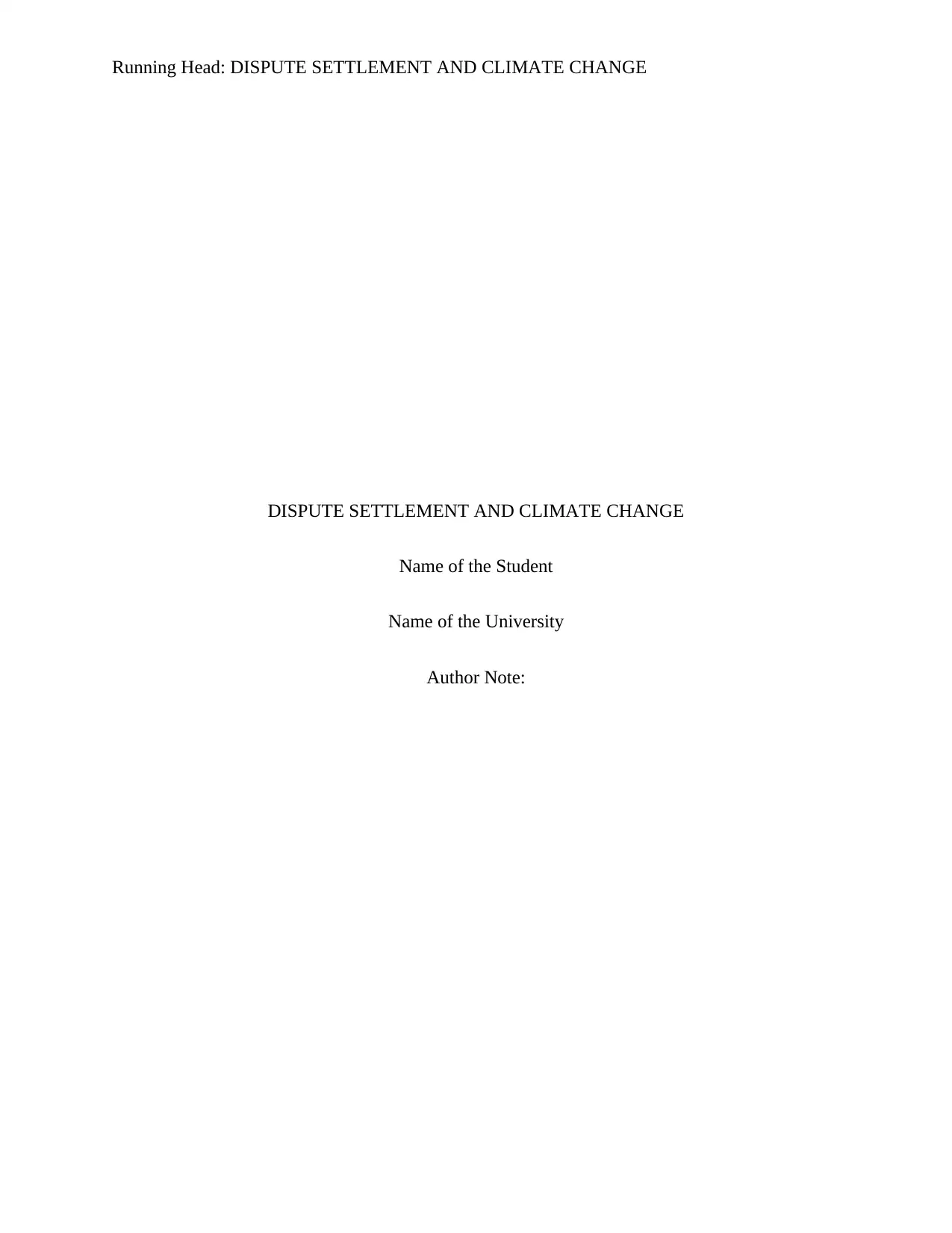
Running Head: DISPUTE SETTLEMENT AND CLIMATE CHANGE
DISPUTE SETTLEMENT AND CLIMATE CHANGE
Name of the Student
Name of the University
Author Note:
DISPUTE SETTLEMENT AND CLIMATE CHANGE
Name of the Student
Name of the University
Author Note:
Paraphrase This Document
Need a fresh take? Get an instant paraphrase of this document with our AI Paraphraser
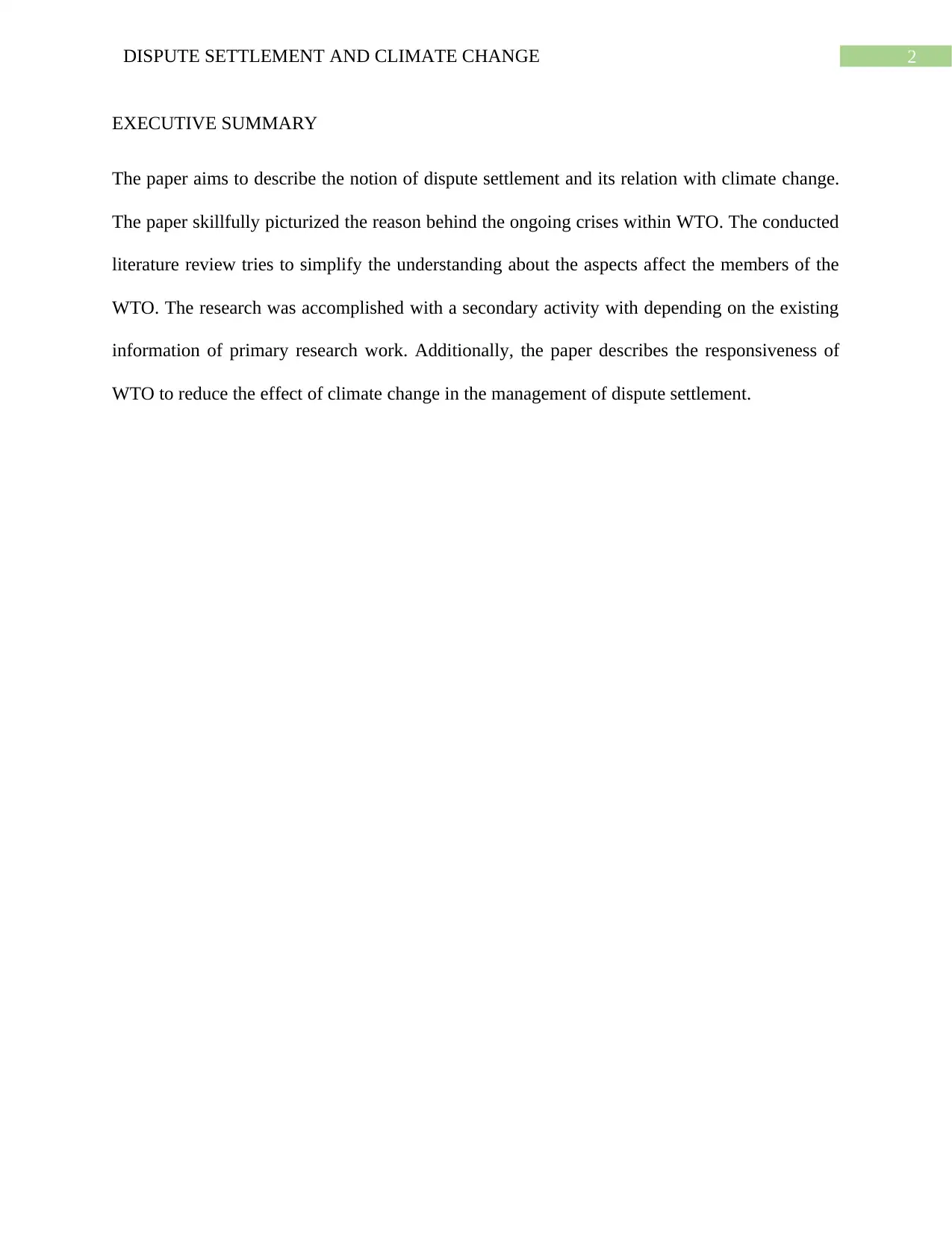
2DISPUTE SETTLEMENT AND CLIMATE CHANGE
EXECUTIVE SUMMARY
The paper aims to describe the notion of dispute settlement and its relation with climate change.
The paper skillfully picturized the reason behind the ongoing crises within WTO. The conducted
literature review tries to simplify the understanding about the aspects affect the members of the
WTO. The research was accomplished with a secondary activity with depending on the existing
information of primary research work. Additionally, the paper describes the responsiveness of
WTO to reduce the effect of climate change in the management of dispute settlement.
EXECUTIVE SUMMARY
The paper aims to describe the notion of dispute settlement and its relation with climate change.
The paper skillfully picturized the reason behind the ongoing crises within WTO. The conducted
literature review tries to simplify the understanding about the aspects affect the members of the
WTO. The research was accomplished with a secondary activity with depending on the existing
information of primary research work. Additionally, the paper describes the responsiveness of
WTO to reduce the effect of climate change in the management of dispute settlement.
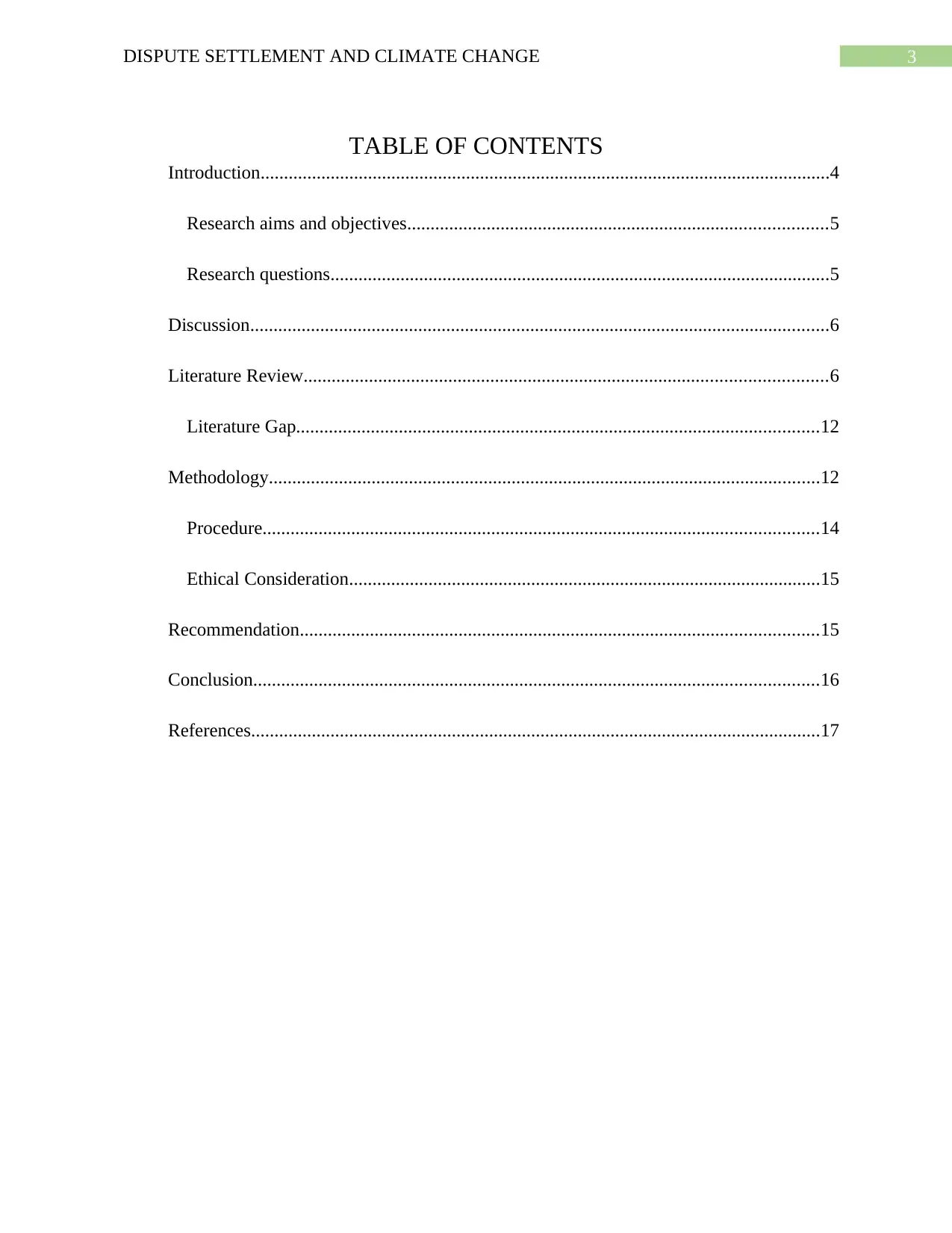
3DISPUTE SETTLEMENT AND CLIMATE CHANGE
TABLE OF CONTENTS
Introduction..........................................................................................................................4
Research aims and objectives..........................................................................................5
Research questions...........................................................................................................5
Discussion............................................................................................................................6
Literature Review................................................................................................................6
Literature Gap................................................................................................................12
Methodology......................................................................................................................12
Procedure.......................................................................................................................14
Ethical Consideration.....................................................................................................15
Recommendation...............................................................................................................15
Conclusion.........................................................................................................................16
References..........................................................................................................................17
TABLE OF CONTENTS
Introduction..........................................................................................................................4
Research aims and objectives..........................................................................................5
Research questions...........................................................................................................5
Discussion............................................................................................................................6
Literature Review................................................................................................................6
Literature Gap................................................................................................................12
Methodology......................................................................................................................12
Procedure.......................................................................................................................14
Ethical Consideration.....................................................................................................15
Recommendation...............................................................................................................15
Conclusion.........................................................................................................................16
References..........................................................................................................................17
⊘ This is a preview!⊘
Do you want full access?
Subscribe today to unlock all pages.

Trusted by 1+ million students worldwide
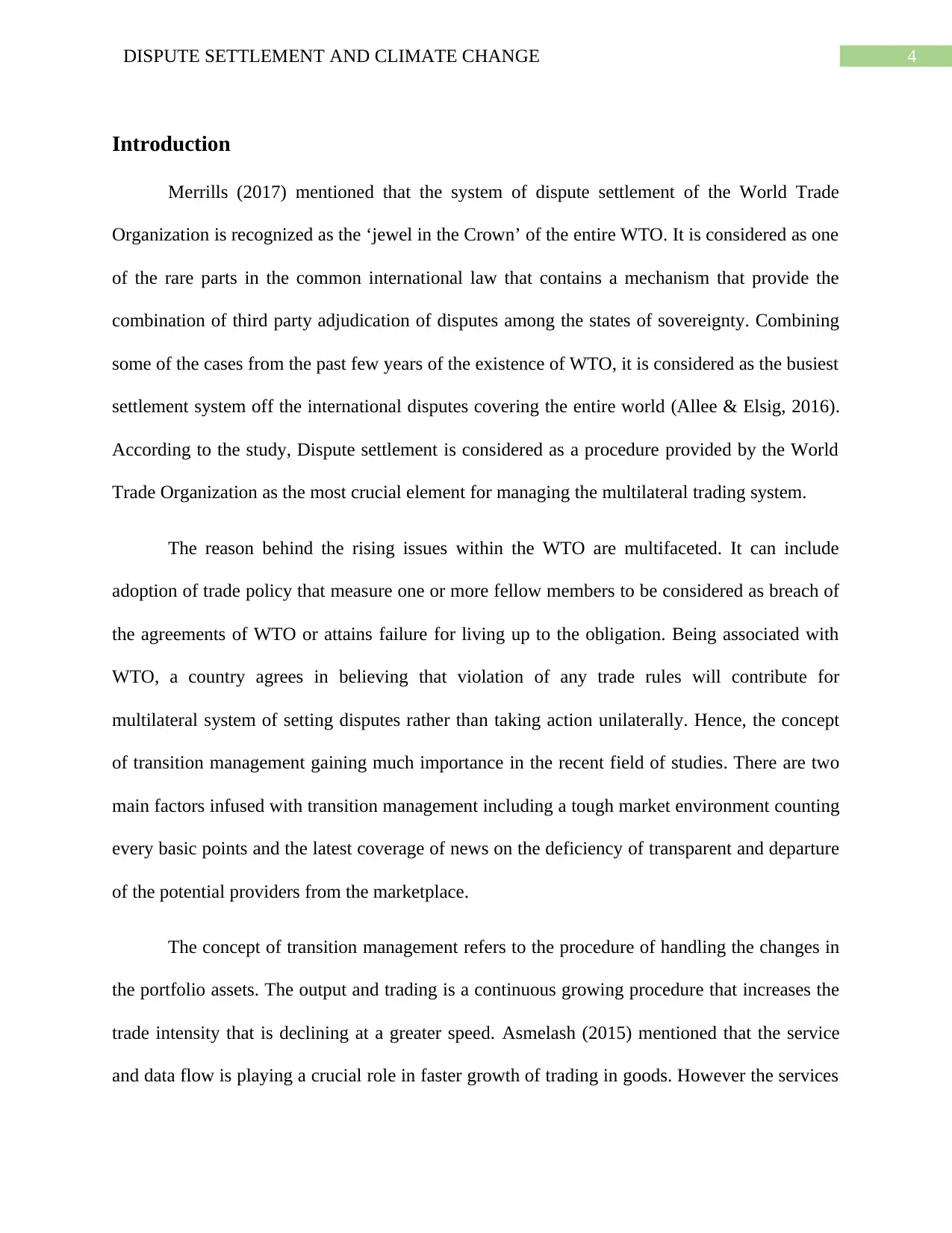
4DISPUTE SETTLEMENT AND CLIMATE CHANGE
Introduction
Merrills (2017) mentioned that the system of dispute settlement of the World Trade
Organization is recognized as the ‘jewel in the Crown’ of the entire WTO. It is considered as one
of the rare parts in the common international law that contains a mechanism that provide the
combination of third party adjudication of disputes among the states of sovereignty. Combining
some of the cases from the past few years of the existence of WTO, it is considered as the busiest
settlement system off the international disputes covering the entire world (Allee & Elsig, 2016).
According to the study, Dispute settlement is considered as a procedure provided by the World
Trade Organization as the most crucial element for managing the multilateral trading system.
The reason behind the rising issues within the WTO are multifaceted. It can include
adoption of trade policy that measure one or more fellow members to be considered as breach of
the agreements of WTO or attains failure for living up to the obligation. Being associated with
WTO, a country agrees in believing that violation of any trade rules will contribute for
multilateral system of setting disputes rather than taking action unilaterally. Hence, the concept
of transition management gaining much importance in the recent field of studies. There are two
main factors infused with transition management including a tough market environment counting
every basic points and the latest coverage of news on the deficiency of transparent and departure
of the potential providers from the marketplace.
The concept of transition management refers to the procedure of handling the changes in
the portfolio assets. The output and trading is a continuous growing procedure that increases the
trade intensity that is declining at a greater speed. Asmelash (2015) mentioned that the service
and data flow is playing a crucial role in faster growth of trading in goods. However the services
Introduction
Merrills (2017) mentioned that the system of dispute settlement of the World Trade
Organization is recognized as the ‘jewel in the Crown’ of the entire WTO. It is considered as one
of the rare parts in the common international law that contains a mechanism that provide the
combination of third party adjudication of disputes among the states of sovereignty. Combining
some of the cases from the past few years of the existence of WTO, it is considered as the busiest
settlement system off the international disputes covering the entire world (Allee & Elsig, 2016).
According to the study, Dispute settlement is considered as a procedure provided by the World
Trade Organization as the most crucial element for managing the multilateral trading system.
The reason behind the rising issues within the WTO are multifaceted. It can include
adoption of trade policy that measure one or more fellow members to be considered as breach of
the agreements of WTO or attains failure for living up to the obligation. Being associated with
WTO, a country agrees in believing that violation of any trade rules will contribute for
multilateral system of setting disputes rather than taking action unilaterally. Hence, the concept
of transition management gaining much importance in the recent field of studies. There are two
main factors infused with transition management including a tough market environment counting
every basic points and the latest coverage of news on the deficiency of transparent and departure
of the potential providers from the marketplace.
The concept of transition management refers to the procedure of handling the changes in
the portfolio assets. The output and trading is a continuous growing procedure that increases the
trade intensity that is declining at a greater speed. Asmelash (2015) mentioned that the service
and data flow is playing a crucial role in faster growth of trading in goods. However the services
Paraphrase This Document
Need a fresh take? Get an instant paraphrase of this document with our AI Paraphraser
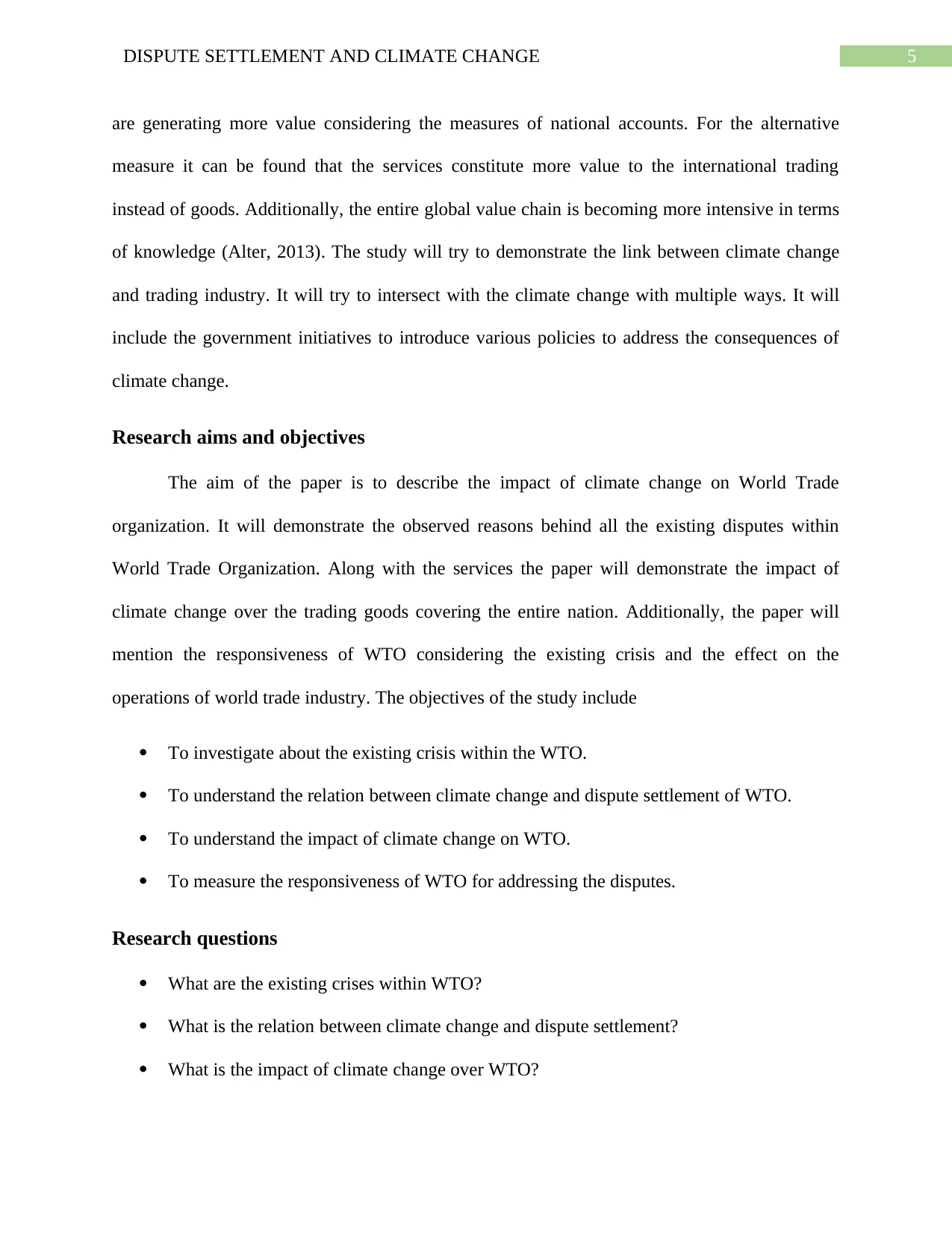
5DISPUTE SETTLEMENT AND CLIMATE CHANGE
are generating more value considering the measures of national accounts. For the alternative
measure it can be found that the services constitute more value to the international trading
instead of goods. Additionally, the entire global value chain is becoming more intensive in terms
of knowledge (Alter, 2013). The study will try to demonstrate the link between climate change
and trading industry. It will try to intersect with the climate change with multiple ways. It will
include the government initiatives to introduce various policies to address the consequences of
climate change.
Research aims and objectives
The aim of the paper is to describe the impact of climate change on World Trade
organization. It will demonstrate the observed reasons behind all the existing disputes within
World Trade Organization. Along with the services the paper will demonstrate the impact of
climate change over the trading goods covering the entire nation. Additionally, the paper will
mention the responsiveness of WTO considering the existing crisis and the effect on the
operations of world trade industry. The objectives of the study include
To investigate about the existing crisis within the WTO.
To understand the relation between climate change and dispute settlement of WTO.
To understand the impact of climate change on WTO.
To measure the responsiveness of WTO for addressing the disputes.
Research questions
What are the existing crises within WTO?
What is the relation between climate change and dispute settlement?
What is the impact of climate change over WTO?
are generating more value considering the measures of national accounts. For the alternative
measure it can be found that the services constitute more value to the international trading
instead of goods. Additionally, the entire global value chain is becoming more intensive in terms
of knowledge (Alter, 2013). The study will try to demonstrate the link between climate change
and trading industry. It will try to intersect with the climate change with multiple ways. It will
include the government initiatives to introduce various policies to address the consequences of
climate change.
Research aims and objectives
The aim of the paper is to describe the impact of climate change on World Trade
organization. It will demonstrate the observed reasons behind all the existing disputes within
World Trade Organization. Along with the services the paper will demonstrate the impact of
climate change over the trading goods covering the entire nation. Additionally, the paper will
mention the responsiveness of WTO considering the existing crisis and the effect on the
operations of world trade industry. The objectives of the study include
To investigate about the existing crisis within the WTO.
To understand the relation between climate change and dispute settlement of WTO.
To understand the impact of climate change on WTO.
To measure the responsiveness of WTO for addressing the disputes.
Research questions
What are the existing crises within WTO?
What is the relation between climate change and dispute settlement?
What is the impact of climate change over WTO?
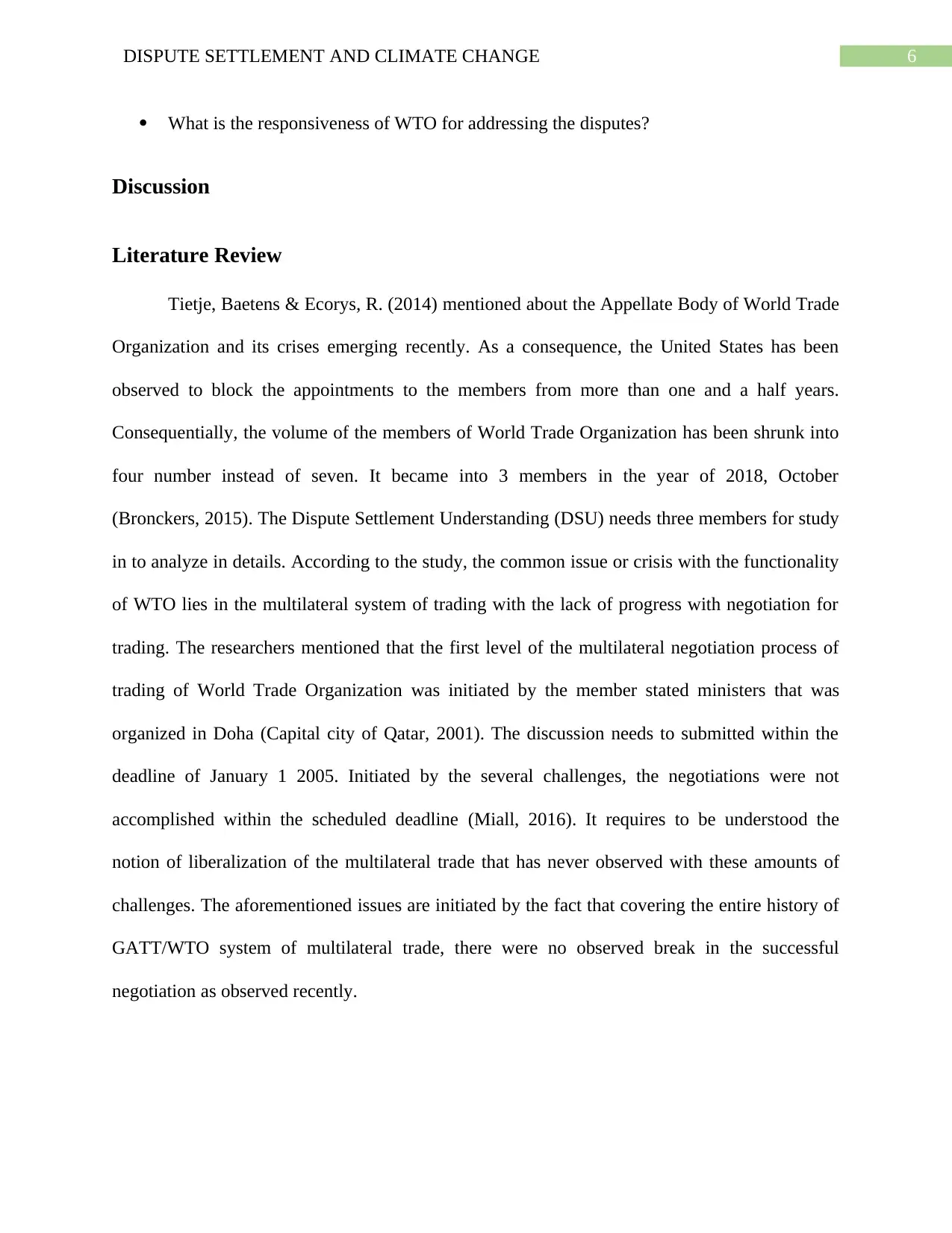
6DISPUTE SETTLEMENT AND CLIMATE CHANGE
What is the responsiveness of WTO for addressing the disputes?
Discussion
Literature Review
Tietje, Baetens & Ecorys, R. (2014) mentioned about the Appellate Body of World Trade
Organization and its crises emerging recently. As a consequence, the United States has been
observed to block the appointments to the members from more than one and a half years.
Consequentially, the volume of the members of World Trade Organization has been shrunk into
four number instead of seven. It became into 3 members in the year of 2018, October
(Bronckers, 2015). The Dispute Settlement Understanding (DSU) needs three members for study
in to analyze in details. According to the study, the common issue or crisis with the functionality
of WTO lies in the multilateral system of trading with the lack of progress with negotiation for
trading. The researchers mentioned that the first level of the multilateral negotiation process of
trading of World Trade Organization was initiated by the member stated ministers that was
organized in Doha (Capital city of Qatar, 2001). The discussion needs to submitted within the
deadline of January 1 2005. Initiated by the several challenges, the negotiations were not
accomplished within the scheduled deadline (Miall, 2016). It requires to be understood the
notion of liberalization of the multilateral trade that has never observed with these amounts of
challenges. The aforementioned issues are initiated by the fact that covering the entire history of
GATT/WTO system of multilateral trade, there were no observed break in the successful
negotiation as observed recently.
What is the responsiveness of WTO for addressing the disputes?
Discussion
Literature Review
Tietje, Baetens & Ecorys, R. (2014) mentioned about the Appellate Body of World Trade
Organization and its crises emerging recently. As a consequence, the United States has been
observed to block the appointments to the members from more than one and a half years.
Consequentially, the volume of the members of World Trade Organization has been shrunk into
four number instead of seven. It became into 3 members in the year of 2018, October
(Bronckers, 2015). The Dispute Settlement Understanding (DSU) needs three members for study
in to analyze in details. According to the study, the common issue or crisis with the functionality
of WTO lies in the multilateral system of trading with the lack of progress with negotiation for
trading. The researchers mentioned that the first level of the multilateral negotiation process of
trading of World Trade Organization was initiated by the member stated ministers that was
organized in Doha (Capital city of Qatar, 2001). The discussion needs to submitted within the
deadline of January 1 2005. Initiated by the several challenges, the negotiations were not
accomplished within the scheduled deadline (Miall, 2016). It requires to be understood the
notion of liberalization of the multilateral trade that has never observed with these amounts of
challenges. The aforementioned issues are initiated by the fact that covering the entire history of
GATT/WTO system of multilateral trade, there were no observed break in the successful
negotiation as observed recently.
⊘ This is a preview!⊘
Do you want full access?
Subscribe today to unlock all pages.

Trusted by 1+ million students worldwide
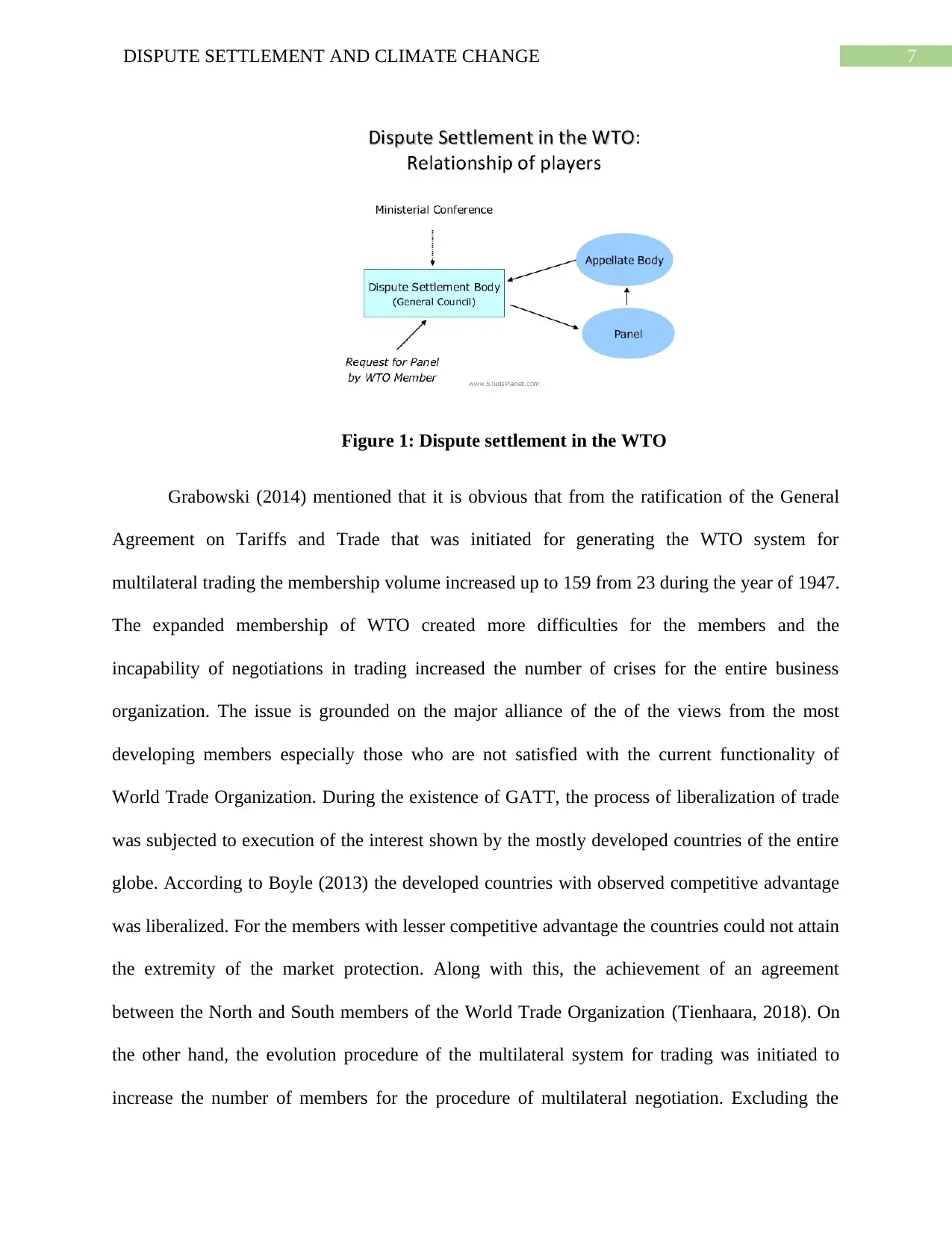
7DISPUTE SETTLEMENT AND CLIMATE CHANGE
Figure 1: Dispute settlement in the WTO
Grabowski (2014) mentioned that it is obvious that from the ratification of the General
Agreement on Tariffs and Trade that was initiated for generating the WTO system for
multilateral trading the membership volume increased up to 159 from 23 during the year of 1947.
The expanded membership of WTO created more difficulties for the members and the
incapability of negotiations in trading increased the number of crises for the entire business
organization. The issue is grounded on the major alliance of the of the views from the most
developing members especially those who are not satisfied with the current functionality of
World Trade Organization. During the existence of GATT, the process of liberalization of trade
was subjected to execution of the interest shown by the mostly developed countries of the entire
globe. According to Boyle (2013) the developed countries with observed competitive advantage
was liberalized. For the members with lesser competitive advantage the countries could not attain
the extremity of the market protection. Along with this, the achievement of an agreement
between the North and South members of the World Trade Organization (Tienhaara, 2018). On
the other hand, the evolution procedure of the multilateral system for trading was initiated to
increase the number of members for the procedure of multilateral negotiation. Excluding the
Figure 1: Dispute settlement in the WTO
Grabowski (2014) mentioned that it is obvious that from the ratification of the General
Agreement on Tariffs and Trade that was initiated for generating the WTO system for
multilateral trading the membership volume increased up to 159 from 23 during the year of 1947.
The expanded membership of WTO created more difficulties for the members and the
incapability of negotiations in trading increased the number of crises for the entire business
organization. The issue is grounded on the major alliance of the of the views from the most
developing members especially those who are not satisfied with the current functionality of
World Trade Organization. During the existence of GATT, the process of liberalization of trade
was subjected to execution of the interest shown by the mostly developed countries of the entire
globe. According to Boyle (2013) the developed countries with observed competitive advantage
was liberalized. For the members with lesser competitive advantage the countries could not attain
the extremity of the market protection. Along with this, the achievement of an agreement
between the North and South members of the World Trade Organization (Tienhaara, 2018). On
the other hand, the evolution procedure of the multilateral system for trading was initiated to
increase the number of members for the procedure of multilateral negotiation. Excluding the
Paraphrase This Document
Need a fresh take? Get an instant paraphrase of this document with our AI Paraphraser
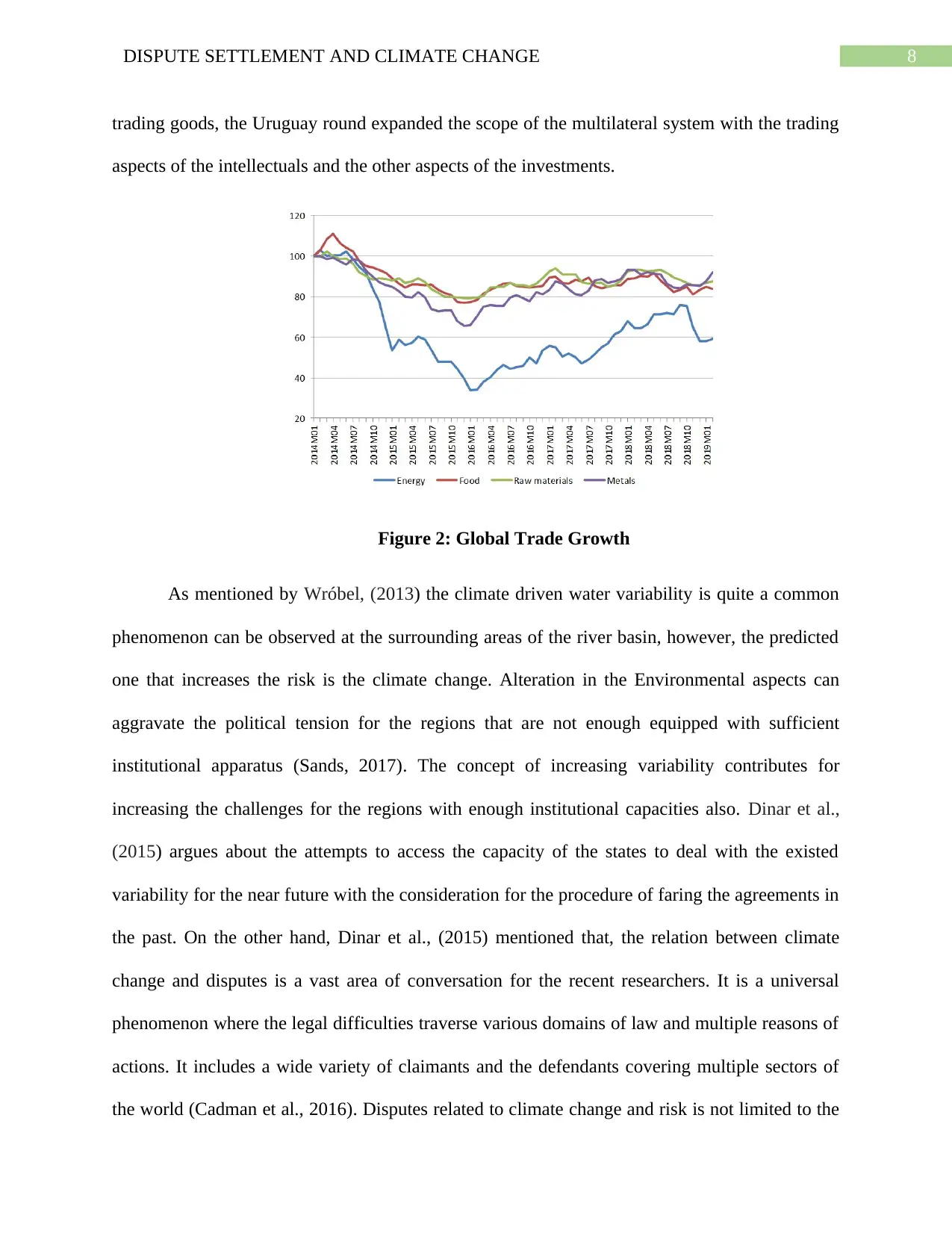
8DISPUTE SETTLEMENT AND CLIMATE CHANGE
trading goods, the Uruguay round expanded the scope of the multilateral system with the trading
aspects of the intellectuals and the other aspects of the investments.
Figure 2: Global Trade Growth
As mentioned by Wróbel, (2013) the climate driven water variability is quite a common
phenomenon can be observed at the surrounding areas of the river basin, however, the predicted
one that increases the risk is the climate change. Alteration in the Environmental aspects can
aggravate the political tension for the regions that are not enough equipped with sufficient
institutional apparatus (Sands, 2017). The concept of increasing variability contributes for
increasing the challenges for the regions with enough institutional capacities also. Dinar et al.,
(2015) argues about the attempts to access the capacity of the states to deal with the existed
variability for the near future with the consideration for the procedure of faring the agreements in
the past. On the other hand, Dinar et al., (2015) mentioned that, the relation between climate
change and disputes is a vast area of conversation for the recent researchers. It is a universal
phenomenon where the legal difficulties traverse various domains of law and multiple reasons of
actions. It includes a wide variety of claimants and the defendants covering multiple sectors of
the world (Cadman et al., 2016). Disputes related to climate change and risk is not limited to the
trading goods, the Uruguay round expanded the scope of the multilateral system with the trading
aspects of the intellectuals and the other aspects of the investments.
Figure 2: Global Trade Growth
As mentioned by Wróbel, (2013) the climate driven water variability is quite a common
phenomenon can be observed at the surrounding areas of the river basin, however, the predicted
one that increases the risk is the climate change. Alteration in the Environmental aspects can
aggravate the political tension for the regions that are not enough equipped with sufficient
institutional apparatus (Sands, 2017). The concept of increasing variability contributes for
increasing the challenges for the regions with enough institutional capacities also. Dinar et al.,
(2015) argues about the attempts to access the capacity of the states to deal with the existed
variability for the near future with the consideration for the procedure of faring the agreements in
the past. On the other hand, Dinar et al., (2015) mentioned that, the relation between climate
change and disputes is a vast area of conversation for the recent researchers. It is a universal
phenomenon where the legal difficulties traverse various domains of law and multiple reasons of
actions. It includes a wide variety of claimants and the defendants covering multiple sectors of
the world (Cadman et al., 2016). Disputes related to climate change and risk is not limited to the
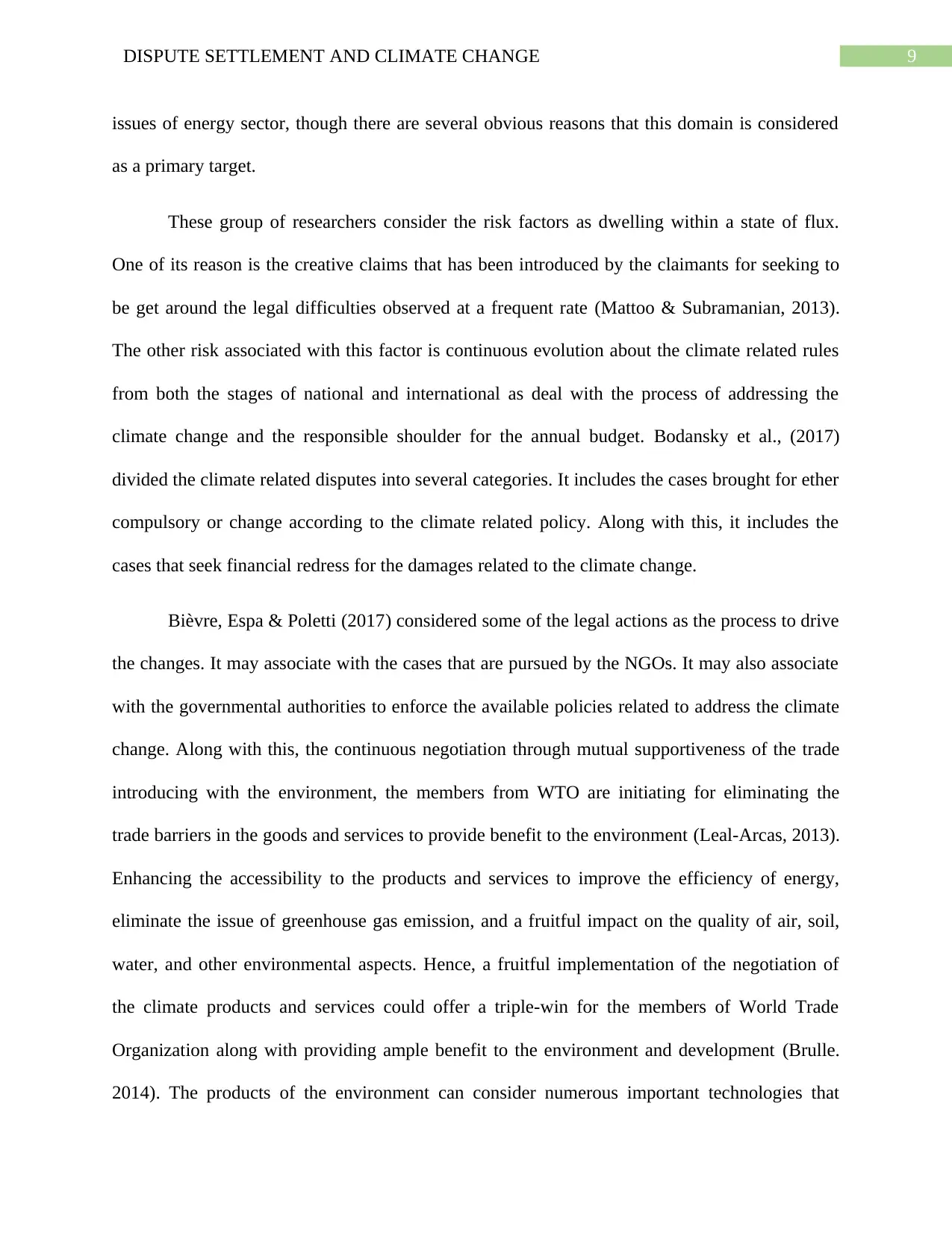
9DISPUTE SETTLEMENT AND CLIMATE CHANGE
issues of energy sector, though there are several obvious reasons that this domain is considered
as a primary target.
These group of researchers consider the risk factors as dwelling within a state of flux.
One of its reason is the creative claims that has been introduced by the claimants for seeking to
be get around the legal difficulties observed at a frequent rate (Mattoo & Subramanian, 2013).
The other risk associated with this factor is continuous evolution about the climate related rules
from both the stages of national and international as deal with the process of addressing the
climate change and the responsible shoulder for the annual budget. Bodansky et al., (2017)
divided the climate related disputes into several categories. It includes the cases brought for ether
compulsory or change according to the climate related policy. Along with this, it includes the
cases that seek financial redress for the damages related to the climate change.
Bièvre, Espa & Poletti (2017) considered some of the legal actions as the process to drive
the changes. It may associate with the cases that are pursued by the NGOs. It may also associate
with the governmental authorities to enforce the available policies related to address the climate
change. Along with this, the continuous negotiation through mutual supportiveness of the trade
introducing with the environment, the members from WTO are initiating for eliminating the
trade barriers in the goods and services to provide benefit to the environment (Leal-Arcas, 2013).
Enhancing the accessibility to the products and services to improve the efficiency of energy,
eliminate the issue of greenhouse gas emission, and a fruitful impact on the quality of air, soil,
water, and other environmental aspects. Hence, a fruitful implementation of the negotiation of
the climate products and services could offer a triple-win for the members of World Trade
Organization along with providing ample benefit to the environment and development (Brulle.
2014). The products of the environment can consider numerous important technologies that
issues of energy sector, though there are several obvious reasons that this domain is considered
as a primary target.
These group of researchers consider the risk factors as dwelling within a state of flux.
One of its reason is the creative claims that has been introduced by the claimants for seeking to
be get around the legal difficulties observed at a frequent rate (Mattoo & Subramanian, 2013).
The other risk associated with this factor is continuous evolution about the climate related rules
from both the stages of national and international as deal with the process of addressing the
climate change and the responsible shoulder for the annual budget. Bodansky et al., (2017)
divided the climate related disputes into several categories. It includes the cases brought for ether
compulsory or change according to the climate related policy. Along with this, it includes the
cases that seek financial redress for the damages related to the climate change.
Bièvre, Espa & Poletti (2017) considered some of the legal actions as the process to drive
the changes. It may associate with the cases that are pursued by the NGOs. It may also associate
with the governmental authorities to enforce the available policies related to address the climate
change. Along with this, the continuous negotiation through mutual supportiveness of the trade
introducing with the environment, the members from WTO are initiating for eliminating the
trade barriers in the goods and services to provide benefit to the environment (Leal-Arcas, 2013).
Enhancing the accessibility to the products and services to improve the efficiency of energy,
eliminate the issue of greenhouse gas emission, and a fruitful impact on the quality of air, soil,
water, and other environmental aspects. Hence, a fruitful implementation of the negotiation of
the climate products and services could offer a triple-win for the members of World Trade
Organization along with providing ample benefit to the environment and development (Brulle.
2014). The products of the environment can consider numerous important technologies that
⊘ This is a preview!⊘
Do you want full access?
Subscribe today to unlock all pages.

Trusted by 1+ million students worldwide
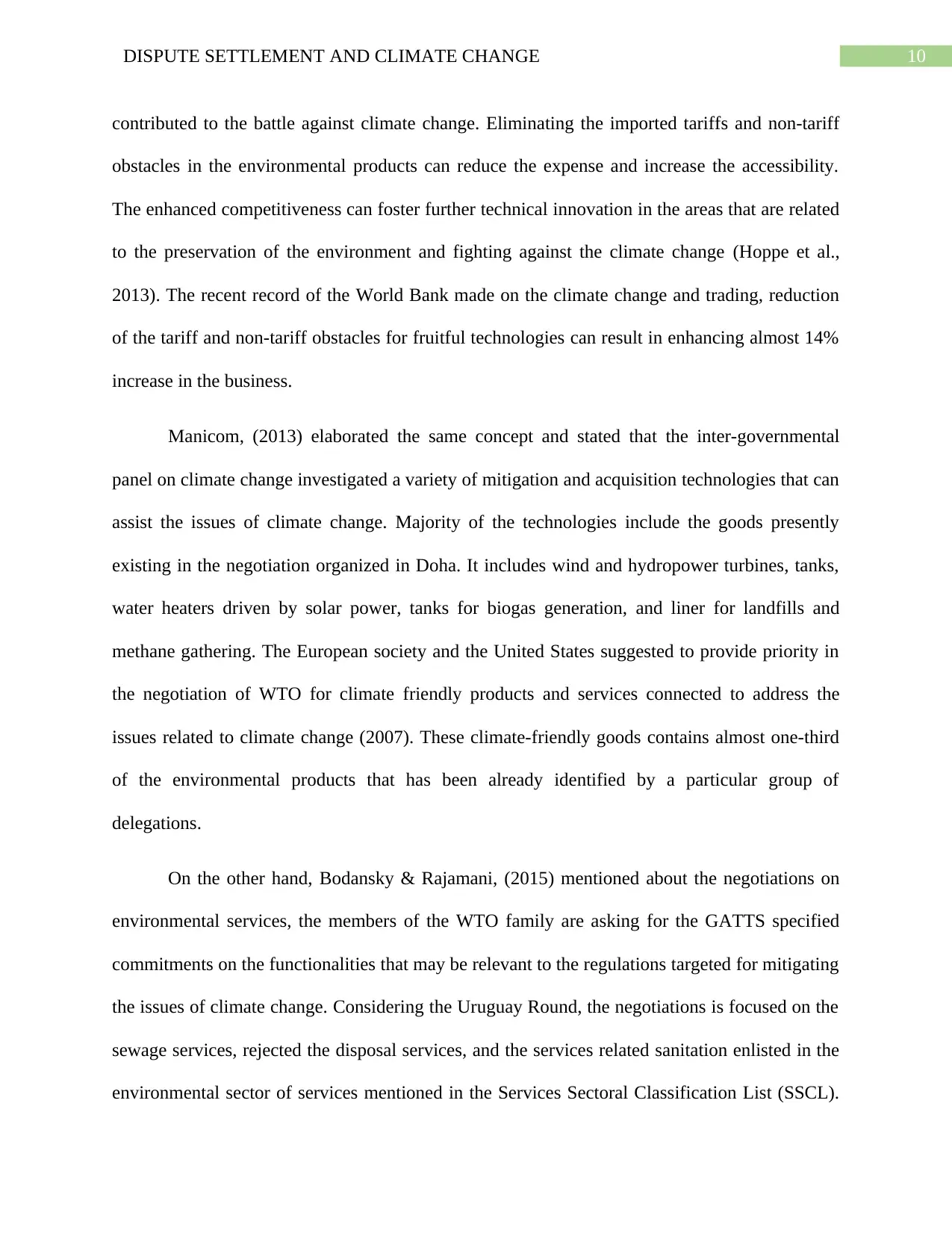
10DISPUTE SETTLEMENT AND CLIMATE CHANGE
contributed to the battle against climate change. Eliminating the imported tariffs and non-tariff
obstacles in the environmental products can reduce the expense and increase the accessibility.
The enhanced competitiveness can foster further technical innovation in the areas that are related
to the preservation of the environment and fighting against the climate change (Hoppe et al.,
2013). The recent record of the World Bank made on the climate change and trading, reduction
of the tariff and non-tariff obstacles for fruitful technologies can result in enhancing almost 14%
increase in the business.
Manicom, (2013) elaborated the same concept and stated that the inter-governmental
panel on climate change investigated a variety of mitigation and acquisition technologies that can
assist the issues of climate change. Majority of the technologies include the goods presently
existing in the negotiation organized in Doha. It includes wind and hydropower turbines, tanks,
water heaters driven by solar power, tanks for biogas generation, and liner for landfills and
methane gathering. The European society and the United States suggested to provide priority in
the negotiation of WTO for climate friendly products and services connected to address the
issues related to climate change (2007). These climate-friendly goods contains almost one-third
of the environmental products that has been already identified by a particular group of
delegations.
On the other hand, Bodansky & Rajamani, (2015) mentioned about the negotiations on
environmental services, the members of the WTO family are asking for the GATTS specified
commitments on the functionalities that may be relevant to the regulations targeted for mitigating
the issues of climate change. Considering the Uruguay Round, the negotiations is focused on the
sewage services, rejected the disposal services, and the services related sanitation enlisted in the
environmental sector of services mentioned in the Services Sectoral Classification List (SSCL).
contributed to the battle against climate change. Eliminating the imported tariffs and non-tariff
obstacles in the environmental products can reduce the expense and increase the accessibility.
The enhanced competitiveness can foster further technical innovation in the areas that are related
to the preservation of the environment and fighting against the climate change (Hoppe et al.,
2013). The recent record of the World Bank made on the climate change and trading, reduction
of the tariff and non-tariff obstacles for fruitful technologies can result in enhancing almost 14%
increase in the business.
Manicom, (2013) elaborated the same concept and stated that the inter-governmental
panel on climate change investigated a variety of mitigation and acquisition technologies that can
assist the issues of climate change. Majority of the technologies include the goods presently
existing in the negotiation organized in Doha. It includes wind and hydropower turbines, tanks,
water heaters driven by solar power, tanks for biogas generation, and liner for landfills and
methane gathering. The European society and the United States suggested to provide priority in
the negotiation of WTO for climate friendly products and services connected to address the
issues related to climate change (2007). These climate-friendly goods contains almost one-third
of the environmental products that has been already identified by a particular group of
delegations.
On the other hand, Bodansky & Rajamani, (2015) mentioned about the negotiations on
environmental services, the members of the WTO family are asking for the GATTS specified
commitments on the functionalities that may be relevant to the regulations targeted for mitigating
the issues of climate change. Considering the Uruguay Round, the negotiations is focused on the
sewage services, rejected the disposal services, and the services related sanitation enlisted in the
environmental sector of services mentioned in the Services Sectoral Classification List (SSCL).
Paraphrase This Document
Need a fresh take? Get an instant paraphrase of this document with our AI Paraphraser
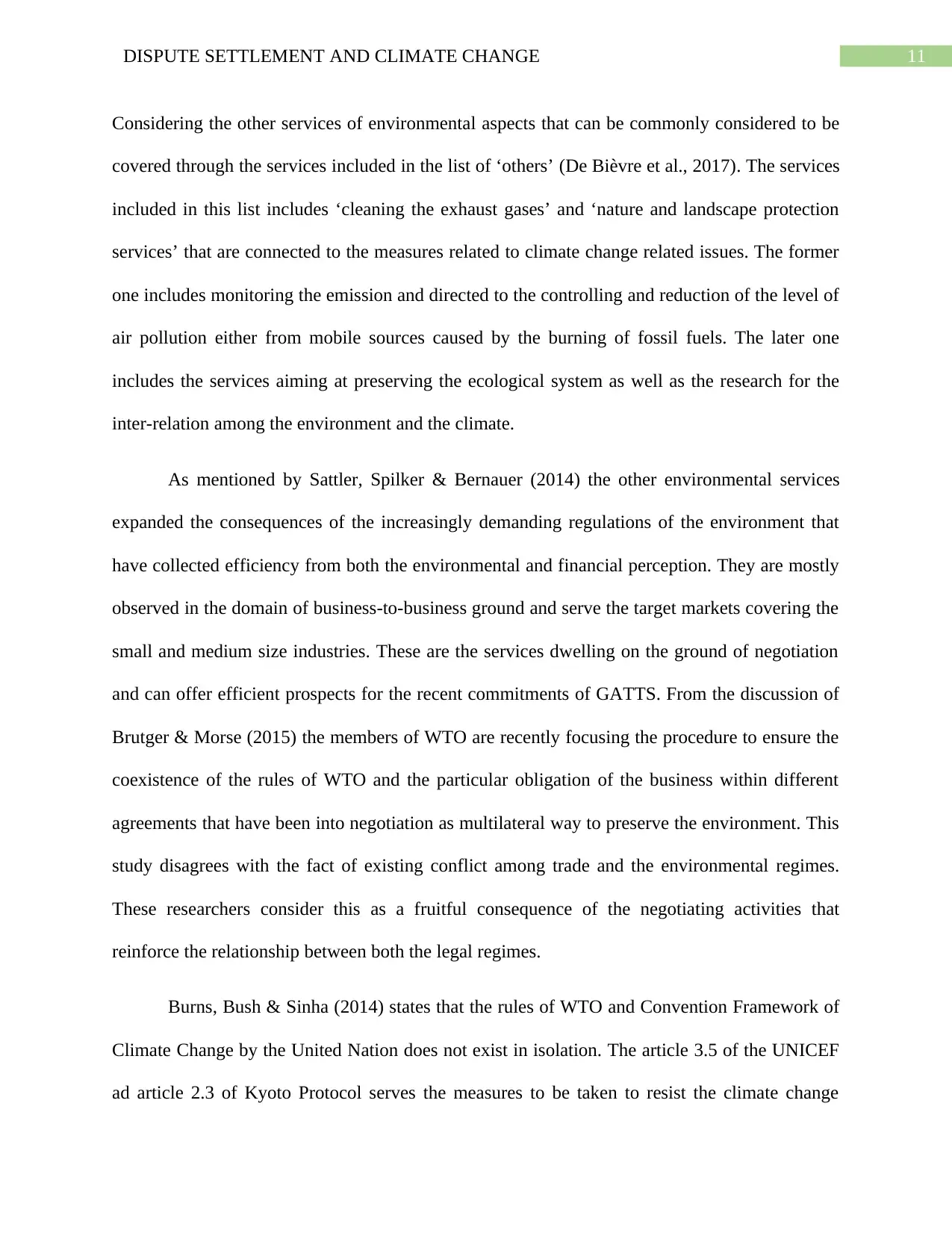
11DISPUTE SETTLEMENT AND CLIMATE CHANGE
Considering the other services of environmental aspects that can be commonly considered to be
covered through the services included in the list of ‘others’ (De Bièvre et al., 2017). The services
included in this list includes ‘cleaning the exhaust gases’ and ‘nature and landscape protection
services’ that are connected to the measures related to climate change related issues. The former
one includes monitoring the emission and directed to the controlling and reduction of the level of
air pollution either from mobile sources caused by the burning of fossil fuels. The later one
includes the services aiming at preserving the ecological system as well as the research for the
inter-relation among the environment and the climate.
As mentioned by Sattler, Spilker & Bernauer (2014) the other environmental services
expanded the consequences of the increasingly demanding regulations of the environment that
have collected efficiency from both the environmental and financial perception. They are mostly
observed in the domain of business-to-business ground and serve the target markets covering the
small and medium size industries. These are the services dwelling on the ground of negotiation
and can offer efficient prospects for the recent commitments of GATTS. From the discussion of
Brutger & Morse (2015) the members of WTO are recently focusing the procedure to ensure the
coexistence of the rules of WTO and the particular obligation of the business within different
agreements that have been into negotiation as multilateral way to preserve the environment. This
study disagrees with the fact of existing conflict among trade and the environmental regimes.
These researchers consider this as a fruitful consequence of the negotiating activities that
reinforce the relationship between both the legal regimes.
Burns, Bush & Sinha (2014) states that the rules of WTO and Convention Framework of
Climate Change by the United Nation does not exist in isolation. The article 3.5 of the UNICEF
ad article 2.3 of Kyoto Protocol serves the measures to be taken to resist the climate change
Considering the other services of environmental aspects that can be commonly considered to be
covered through the services included in the list of ‘others’ (De Bièvre et al., 2017). The services
included in this list includes ‘cleaning the exhaust gases’ and ‘nature and landscape protection
services’ that are connected to the measures related to climate change related issues. The former
one includes monitoring the emission and directed to the controlling and reduction of the level of
air pollution either from mobile sources caused by the burning of fossil fuels. The later one
includes the services aiming at preserving the ecological system as well as the research for the
inter-relation among the environment and the climate.
As mentioned by Sattler, Spilker & Bernauer (2014) the other environmental services
expanded the consequences of the increasingly demanding regulations of the environment that
have collected efficiency from both the environmental and financial perception. They are mostly
observed in the domain of business-to-business ground and serve the target markets covering the
small and medium size industries. These are the services dwelling on the ground of negotiation
and can offer efficient prospects for the recent commitments of GATTS. From the discussion of
Brutger & Morse (2015) the members of WTO are recently focusing the procedure to ensure the
coexistence of the rules of WTO and the particular obligation of the business within different
agreements that have been into negotiation as multilateral way to preserve the environment. This
study disagrees with the fact of existing conflict among trade and the environmental regimes.
These researchers consider this as a fruitful consequence of the negotiating activities that
reinforce the relationship between both the legal regimes.
Burns, Bush & Sinha (2014) states that the rules of WTO and Convention Framework of
Climate Change by the United Nation does not exist in isolation. The article 3.5 of the UNICEF
ad article 2.3 of Kyoto Protocol serves the measures to be taken to resist the climate change
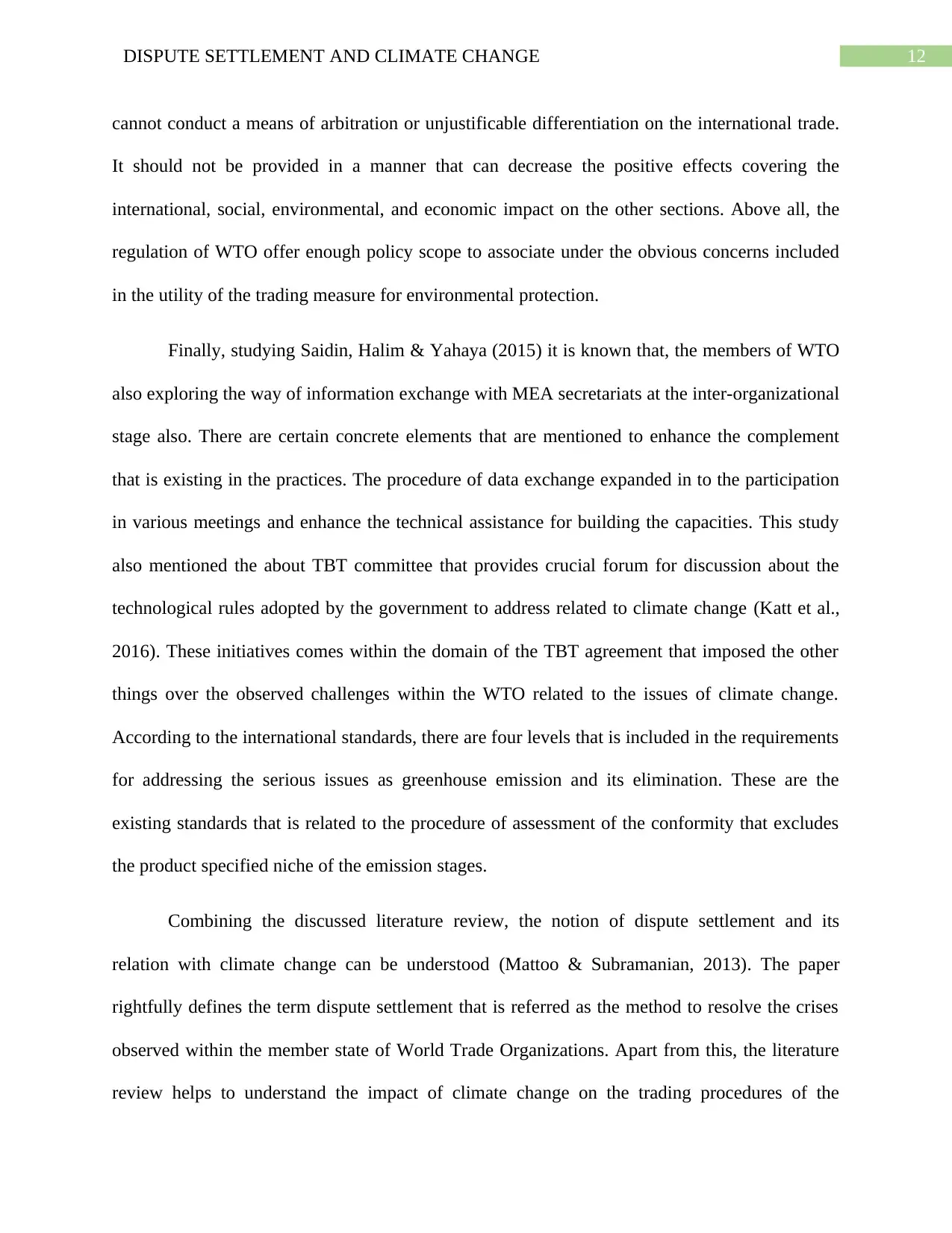
12DISPUTE SETTLEMENT AND CLIMATE CHANGE
cannot conduct a means of arbitration or unjustificable differentiation on the international trade.
It should not be provided in a manner that can decrease the positive effects covering the
international, social, environmental, and economic impact on the other sections. Above all, the
regulation of WTO offer enough policy scope to associate under the obvious concerns included
in the utility of the trading measure for environmental protection.
Finally, studying Saidin, Halim & Yahaya (2015) it is known that, the members of WTO
also exploring the way of information exchange with MEA secretariats at the inter-organizational
stage also. There are certain concrete elements that are mentioned to enhance the complement
that is existing in the practices. The procedure of data exchange expanded in to the participation
in various meetings and enhance the technical assistance for building the capacities. This study
also mentioned the about TBT committee that provides crucial forum for discussion about the
technological rules adopted by the government to address related to climate change (Katt et al.,
2016). These initiatives comes within the domain of the TBT agreement that imposed the other
things over the observed challenges within the WTO related to the issues of climate change.
According to the international standards, there are four levels that is included in the requirements
for addressing the serious issues as greenhouse emission and its elimination. These are the
existing standards that is related to the procedure of assessment of the conformity that excludes
the product specified niche of the emission stages.
Combining the discussed literature review, the notion of dispute settlement and its
relation with climate change can be understood (Mattoo & Subramanian, 2013). The paper
rightfully defines the term dispute settlement that is referred as the method to resolve the crises
observed within the member state of World Trade Organizations. Apart from this, the literature
review helps to understand the impact of climate change on the trading procedures of the
cannot conduct a means of arbitration or unjustificable differentiation on the international trade.
It should not be provided in a manner that can decrease the positive effects covering the
international, social, environmental, and economic impact on the other sections. Above all, the
regulation of WTO offer enough policy scope to associate under the obvious concerns included
in the utility of the trading measure for environmental protection.
Finally, studying Saidin, Halim & Yahaya (2015) it is known that, the members of WTO
also exploring the way of information exchange with MEA secretariats at the inter-organizational
stage also. There are certain concrete elements that are mentioned to enhance the complement
that is existing in the practices. The procedure of data exchange expanded in to the participation
in various meetings and enhance the technical assistance for building the capacities. This study
also mentioned the about TBT committee that provides crucial forum for discussion about the
technological rules adopted by the government to address related to climate change (Katt et al.,
2016). These initiatives comes within the domain of the TBT agreement that imposed the other
things over the observed challenges within the WTO related to the issues of climate change.
According to the international standards, there are four levels that is included in the requirements
for addressing the serious issues as greenhouse emission and its elimination. These are the
existing standards that is related to the procedure of assessment of the conformity that excludes
the product specified niche of the emission stages.
Combining the discussed literature review, the notion of dispute settlement and its
relation with climate change can be understood (Mattoo & Subramanian, 2013). The paper
rightfully defines the term dispute settlement that is referred as the method to resolve the crises
observed within the member state of World Trade Organizations. Apart from this, the literature
review helps to understand the impact of climate change on the trading procedures of the
⊘ This is a preview!⊘
Do you want full access?
Subscribe today to unlock all pages.

Trusted by 1+ million students worldwide
1 out of 22
Related Documents
Your All-in-One AI-Powered Toolkit for Academic Success.
+13062052269
info@desklib.com
Available 24*7 on WhatsApp / Email
![[object Object]](/_next/static/media/star-bottom.7253800d.svg)
Unlock your academic potential
Copyright © 2020–2025 A2Z Services. All Rights Reserved. Developed and managed by ZUCOL.





